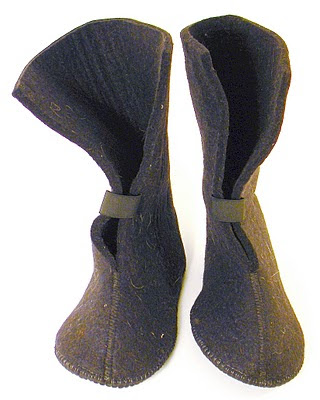Rubber Boots
Rubber Boots are widely available and can be purchased for as little as $10. Some of the different names for Rubber Boots are: Rain Boots, Chore Boots, Barn Boots, Tractor Boots, Slush Boots, Billy Boots and Swampers. Rubber Boots are generally scent-free and are superior to vinyl boots for traction, flexibility and durability.
 |
|
A handsome pair of Swampers
|
Sources for Boots
The best sources for Rubber Boots are online rubber boot outlets, Safety Equipment Suppliers, Farm/Fleet Stores, Tractor Supplies and Sporting Goods Stores.
Boot Selection
You must select a larger boot, 3-4 sizes larger and wider than you normally wear. Only an oversized boot will allow an added insole, liner and thermal socks. If you have a large, wide foot or have trouble getting boots off, you should select an Overboot. Choose boots with dull, ecological colors for hunting, fishing or hiking. Make sure boots are labeled for sale as “Waterproof”.
The best sources for Rubber Boots are online rubber boot outlets, Safety Equipment Suppliers, Farm/Fleet Stores, Tractor Supplies and Sporting Goods Stores.
Boot Selection
You must select a larger boot, 3-4 sizes larger and wider than you normally wear. Only an oversized boot will allow an added insole, liner and thermal socks. If you have a large, wide foot or have trouble getting boots off, you should select an Overboot. Choose boots with dull, ecological colors for hunting, fishing or hiking. Make sure boots are labeled for sale as “Waterproof”.
- Style 826BB
- 12” Height
- 8mm Pressed Wool
- Reinforced Heel
I chose Boot Liners from The Felt Store because they have Boot Liners that are specific for “Barn Boots” or tall, Rubber Boots. Furthermore, after contacting numerous Boot Liner outlets, only The Felt Store replied with personal, detailed advice.
The Felt Store is a US and Canadian company that offers felt, wool, quilted, metallic faced and even Thinsulate™ Boot Liners for cold weather and most types of boot styles. The Felt Store also has insoles and Thermal Socks.
Reinforced Heel
The Felt Store is a technical, industrial supplier as well as a gentle purveyor of felt and woolen items.
Contact The Felt Store:
I certainly wanted to include “Thinsulate” for these project boots. Thinsulate™ is a thin, airy, microfiber material that insulates and manages moisture. I contacted 3M™ and requested an opportunity to evaluate the new 3M™ Thinsulate™ Thermal Insoles because these insoles have a strong presence and accessibility in stores and online.

The Thinsulate™ soles fit easily, feel really good, and are a convenient way to improve the performance of any boot or shoe during cold weather.
Here is a link for a very useful hand-out from 3M™ with advice for staying warm:
Socks
Nowadays, two pairs of socks are recommended for outdoor activities; a thin, liner sock and a thick, outer sock. I wear a thin soccer sock that reaches my knees and provides comfortable compression. Over these, I wear thermal boot socks rated for below freezing.
Snow and Gravel Guards
I picked up some “Gravel/Snow Guards” at a clearance sale. These are made from Neoprene and wrap around boots with Velcro.
Pac | Pack Boots
Pack Boot is a term used to describe boots with removable linings. The main purpose of this type of boot is so that all the different parts of the boot can be removed, separated and dried between uses. Drying boots is very important during severe, cold weather.
Update | My Favorite Boot
Because I have
very wide feet, Overboots are now my preferred boots. Overboots are much wider
than other styles of boots. I purchased an inexpensive pair of overboots
that were on sale from Milwaukee
About:
I requested the opportunity to independently test, review and give opinion for 3M™ Thinsulate™ Thermal Insoles. I utilized donated products for this purpose. Currently, I am not otherwise affiliated or associated with 3M™ and have not received pecuniary compensation or incentive from 3M™.
I requested the opportunity to independently test, review and give opinion for The Felt Store’s Boot Liners. I received a very small discount coupon for this. Currently, I am not otherwise affiliated or associated with The Felt Store and have not received pecuniary compensation or incentive from The Felt Store.












































